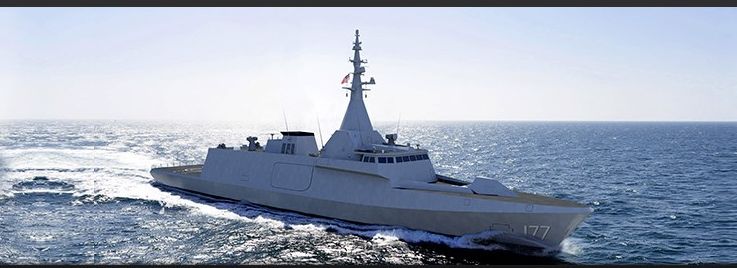
SHAH ALAM: THE keel laying ceremony for the first LCS is scheduled next week, March 8 at the Boustead Naval Shipyard (BNS) in Lumut. Defence Minister Datuk Seri Hishammuddin Hussein is expected to be the guest of honour.
From Wikipedia “Laying the keel, or laying down is the formal recognition of the start of a ship’s construction. It is often marked with a ceremony attended by dignitaries from the shipbuilding company and the ultimate owners of the ship.
What is a keel? From Wikipedia “A structural keel is a beam around which the hull of a ship is built. The keel runs in the middle of the ship, from the bow to the stern, and serves as a basic foundation or spine of the structure, providing the major source of structural strength of the hull.”
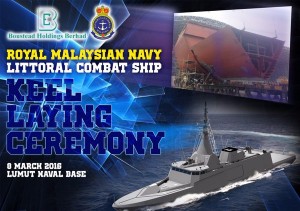
The first LCS is expected to be commission into RMN in 2019. Although the navy described the LCS as a frigate, many others called her a ‘corvette”. Indeed her sister ships in the Egyptian Navy – to be built by DCNS – to the same design although with probably different weapons and sensor fit are described as corvettes.
Anyhow Boustead Heavy Industries Corporation (BHIC), the parent company of BNS seemed to think that it is a corvette or PV class. This is based on the rendering of the LCS on its website, complete (below) with the pennant number 177.
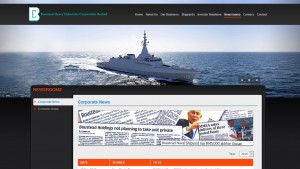
177 is the next pennant number from the Kedah class. Does this mean that the LCS will be name after the remaining states in Malaysia? The two patrol boats based in Sandakan, KD Sri Johor and KD Sri Perlis, are still in service , however.
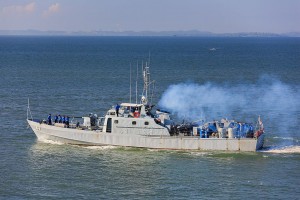
Will the first two LCS be named after the two states so these long serving boats could finally be retired? So many questions and so little answers!
— Malaysian Defence
If you like this post, buy me an espresso. Paypal Payment
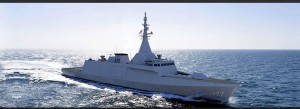

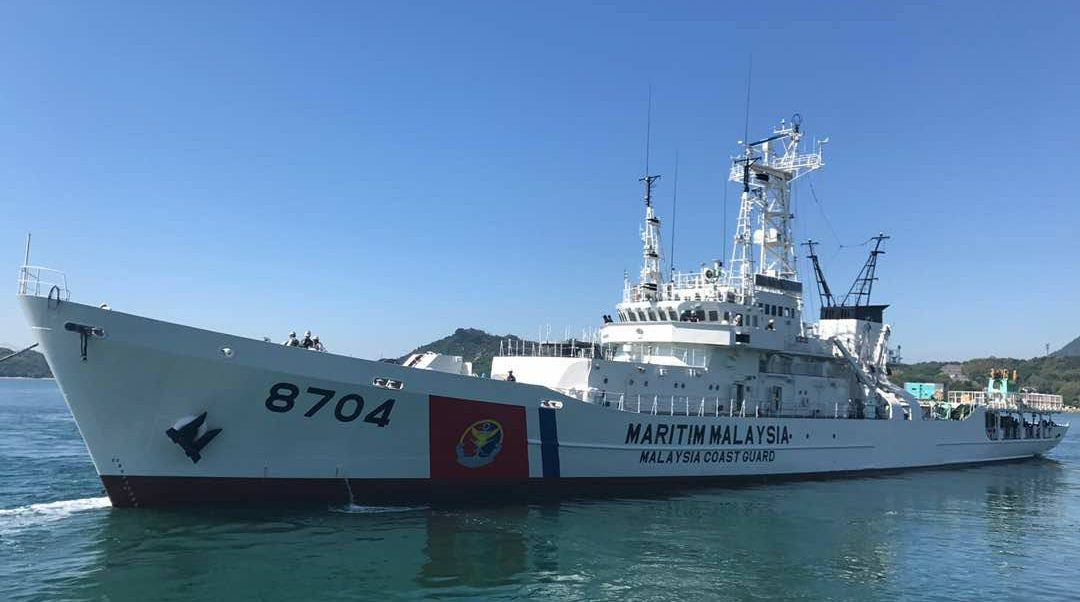
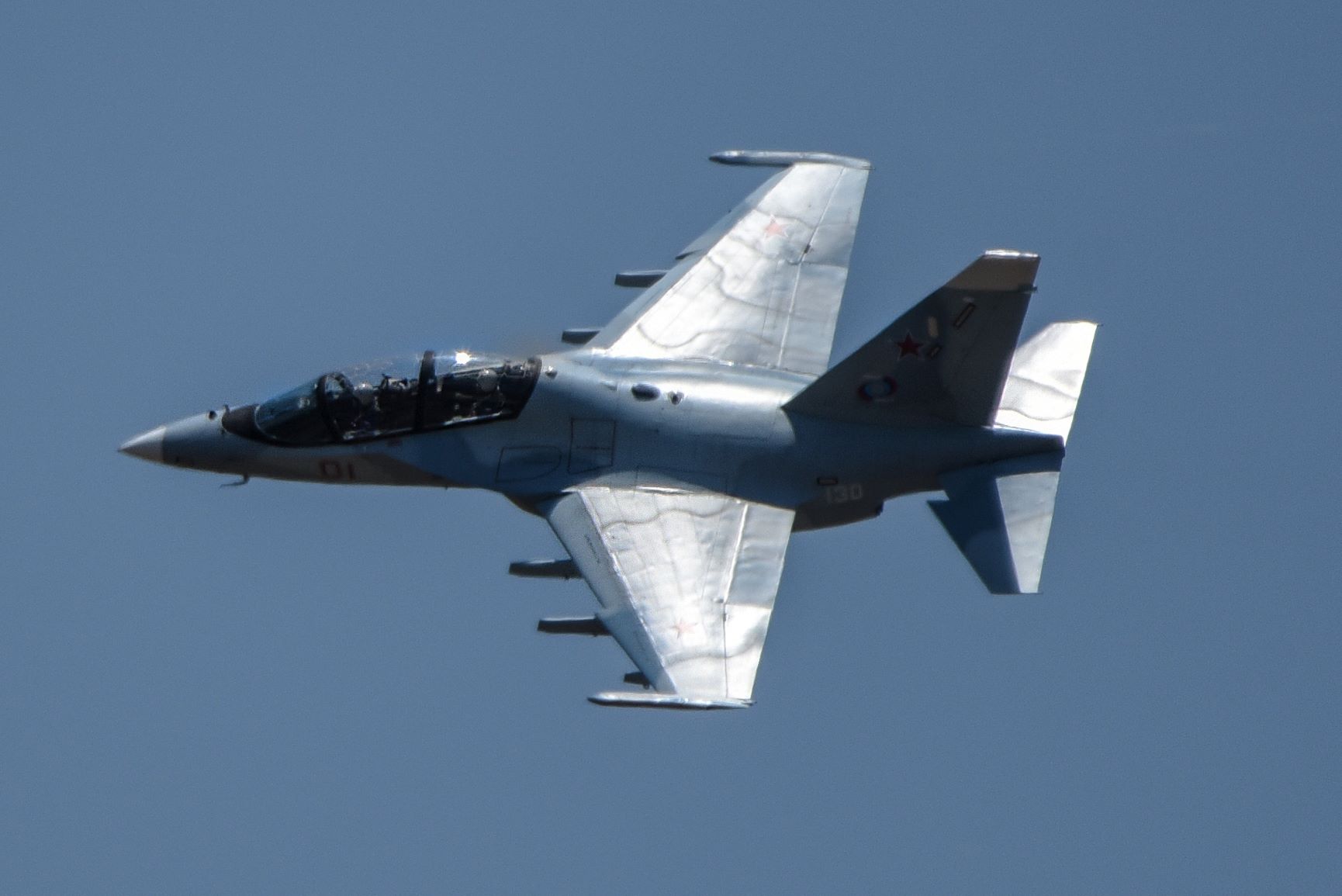

The egyptian gowinds are to be built to the original gowind corvette design, with a displacement of 2500tonnes.
Malaysian gowinds are enlarged to a frigate size due to the budget allocation increase for the programme. The malaysian gowinds displaces 3100tonnes.
The important questions to ask during the ceremony is:
1) The intended name for the 1st ship or even the proposed pennant number. 177 would indicate following the names of states, 31 or 77 would indicate the name of warriors. There is still 5 state names available (penang, negeri sembilan, melaka, sabah, sarawak), but it would be odd if johor is omitted from an important ship like the gowinds. Names of the 5 famous melaka warriors is all stil in use.
2) confirmation of the vshorad.
3) preferred asw helicopters for the gowinds. Would tldm consider used helicopters like upgraded lynx or Australian seahawks?
4) any plans for boustead to actively export ships to fulfil Asian (Philippines for example), middle east and Australian naval upgrading programmes.
5) possibility of exporting meko100 or gowind derived ships?
Unrelated but it would also be good to know the current status of laksamana and ngpv upgrades.
Slownya. Ingatkan dah under construction.
Since the first steel was cut in Dec 2014 I thought the first ship was further along by now and yet we are just at the keel laying ceremony. Well here is to smooth progress from now on and hopefully the ships will be completed on time.
Reply
You cannot expect miracles from a cold yard.
next time beli ready stock je supaya lebih jimat. masa brunei offer dulu, kerajaan jual mahal pulak. kalau nak buat 6 bijik kapal ni pun dah ambik masa 10 tahun, tak guna la membazir duit dengan ToT dan membeli blueprint NGPV dan SGPV sebab lepas 10 tahun, berkemungkinan besar kapal2 yang sedang dibina sekarang telah dianggap oleh kerajaan kita sebagai sedikit ketinggalan zaman . lagi pun, kalau tak salah aku malaysia tak pernah pun lagi mendapat manfaat daripada pembelian blueprint kapal2 perang kita. yang mendapat manfaat ToT pun, hanya syarikat pembina kapal sahaja. satu2nya projek contoh yang mendapat manfaat pembelian blueprint dan ToT adalah projek AV8 gempita. projek NGPV, lepas siap 6 biji terus senyap. SGPV ni pun berkemungkinan besar akan terhenti diangka 6 sahaja. kemudian tutup buku, then create lagi projek baru dengan kos berbilion RM dengan alasan blueprint dan ToT yang sama yang sebenarnya tak bermanfaat mana pun. kita tunggu je la third generation patrol vessal (TGPV), FGPV dan seterusnya… yang pastinya nyawa angota2 keselamatan kita dianggap murah oleh orang2 yang kat atas nun…
There are plans to sell the LCS to foreign customers; just like there are plans to sell the AV-8. Whether any orders are actually gained is off course the million ringgit question.
There is currently zero progress on the Laksamana and Kedah upgrades as funding; let alone approval for the upgrades has yet to come. With the Laksamanas, the current priority is to fit them with a low cost fire director to enable the main gun to be fired : some in the RMN jokingly refer to the class to the FAC [GPMG]; in reference to the fact that without a new fire director, even the main gun can’t be fired.
There is no requirement for a pre-used helo.
With the increased activity in the SCS, the LCS project is timely. As the design is modular and multi mission, it is expected more modules (perhaps even specialized one) will be developed by the local team to be integrated with the main ship control system. Let’s us wish the team all the best!
Before we even think about various future modules; lets first hope that the ships are delivered on time, on spec and within budget. Any integration of future modules – irrespective of whether developed locally [highly unlikely] or abroad – will need the assistance of the CMS’s OEM as only the OEM has the needed source/object codes. There is also the question of whether there is any deck space for modules to be added at a later date.
Azlan,
CMS is considered a handpick equipment. If the contract was not signed with term guarantees the access to interface level, someone is not doing his/her job.
gonggok,
Modules may be built before the hull section. After all, they are just independent sections mate together.
“CMS is considered a handpick equipment. If the contract was not signed with term guarantees the access to interface level, someone is not doing his/her job.
Not true. Most end users simply have no need for the source code.
Just like the Mahathir Hornet saga, talking about being cheated out of the source code (as if such a major thing is given free) when we never asked to buy it at all.
Wether NGPV or LCS design, if Malaysian shipyard don’t prove themselves to be efficient eg. delivery on time, which country would buy from us?
H,
Not sure what you mean about ”handpick” equipment but if there are plans in the future to integrate stuff to the CMS that has not yet been integrated; then we will have to depend on the OEM to provide the needed software codes to enable integration.
AM – ”Just like the Mahathir Hornet saga, talking about being cheated out of the source code (as if such a major thing is given free) when we never asked to buy it at all.”
Quite a few cried foul but there were unaware that not only do all countries [including Russia] not readily hand out source and object codes but also why any country would do so with a customer that just buys a mere 8 aircraft. Like everyone else, if a customer [for whatever reason] needs access to source or object codes; the U.S. handles it on a request basis. One of the delays faced with the Fulcrum simulator contract with CAE was delays on the part of the Russians to provide CAE with the needed codes to enable CAE to simulate the flight characteristics of the Fulcrum in the simulator.
Azlan
Do elaborate on the mig “source cod”, its connection with the plane flight characteristics and the flight simulator developed by CAE.
In fact this is the most ambitious and highly complex military project done in Malaysia so far
As a matter of pride, we wish BHIC all the best
Shed,
The simulator was delayed because the Russians were slow in providing CAE with certain codes and data that were needed for CAE to ”simulate” the Fulcrum. This was reported in the defence press in the 1990’s.
The local defence contractors must learn to move up the technical competency ladder, from a mere structural and steel fabricator to system integrator….easier said than done. For that technology cooperation must be there and creation of paid for prototypes must be encouraged. However with bean counters running the show, this may remain as a dream only. We have to develop our own platform or improve the existing one.
@ zaidi
There is another way of preserving knowhow and technical competency.
Export…
Tot, and all these perishable skills will be lost when the project finishes.
The government must actively push the export of malaysian defence products and services.
It can be done through 2 way trading between friendly countries.
For example we could trade meko100 opv with helicopters or aircrafts from Indonesia, or Pakistan.
For armoured vehicles, comprehensive reset and upgrade programme would also retain the technical knowhow. For example additional ifv requirements could be fulfilled by getting surplus m113 or aifv hulls and refurbished in malaysia to similar standards to the acv adnan.
P.S.
In the 1980’s, we established a joint working group with Singapore to explore the possibility of joint production and procurement. Apart from agreeing to look into the possibility of jointly producing 12.7mm ammo [at this stage CIS was already producing/license manufacturing it; not sure about SME]; things never really got off.
The CN-235 deal also involved barter. The Indonesians were supposed to have bought thousands of Protons and a few Aerotigas in exchange for us buying CN-235s. Some years ago the then Defence Minister spoke of exporting M-4s to regional countries. Why these countries would want to buy from us and how price competitive our M-4s would be after paying royalties to Colt was never explained. Some 20 years previously, we said the same thing about the AUG; that we could export it. Amongst the countries we tried to sell AUGs to – in the late 1990’s – was Pakistan and Syria …… And thanks to Marhalim, we know about the attempt to sell surplus AUGs to Burundi.
Zaidi,
Despite how innovative local defence companies are, how far they advance or what they develop; at the end of the day they must be able to recoup their costs by government orders. If the government can’t commit to orders, how can the companies survive and make a profit?